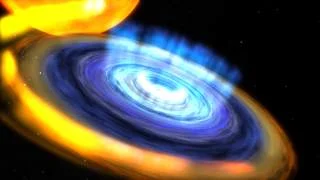NASA’s Rossi X-ray Timing Explorer (RXTE) satellite has identified a candidate for the smallest-known black hole.
The data is based on a specific type of X-ray pattern – nicknamed a “heartbeat” because of its resemblance to an electrocardiogram – that has only been recorded in one other black hole system.

Dubbed IGR J17091-3624, the binary system pairs a normal star with a black hole that may weigh less than three times the sun’s mass, near the theoretical boundary where black-hole status first becomes possible.
Astronomers originally became aware of the binary system during an outburst or flare up around the suspected black hole in 2003 which is typically caused by gas from a normal star streaming towards a black hole and forming a disk around it. Friction within the disk heats the gas to millions of degrees, which is hot enough to emit X-rays.
Cyclical variations in the intensity of the observed X-rays reflect processes taking place within the gas disk. Scientists think that the most rapid changes occur near the black hole’s event horizon, the point beyond which nothing, not even light, can escape.
Archival data from various space missions indicate IGR J17091-3624 becomes active every few years, with its most recent (ongoing) outburst kicking off in February. The system is located in the direction of the constellation Scorpius, but its distance is not well established. It could be as close as 16,000 light-years or more than 65,000 light-years away.
Interestingly enough, the record-holder for wide-ranging X-ray variability is another black hole binary system named GRS 1915+105. This system is unique in displaying more than a dozen highly structured patterns, typically lasting between seconds and hours.
“We think that most of these patterns represent cycles of accumulation and ejection in an unstable disk, and we now see seven of them in IGR J17091,” explained Tomaso Belloni at Brera Observatory in Merate, Italy. ”Identifying these signatures in a second black hole system is very exciting.”
In GRS 1915, strong magnetic fields near the black hole’s event horizon eject some of the gas into dual, oppositely directed jets that blast outward at about 98 percent the speed of light. The peak of its heartbeat emission corresponds to the emergence of the jet.
Changes in the X-ray spectrum observed by RXTE during each beat reveal the innermost region of the disk emits enough radiation to push back the gas, creating a strong outward wind that stops the inward flow, briefly starving the black hole and shutting down the jet – which corresponds to the faintest emission. Eventually, the inner disk gets so bright and hot it essentially disintegrates and plunges toward the black hole, re-establishing the jet and beginning the cycle anew. This entire process happens in as little as 40 seconds.
While there is no direct evidence IGR J17091 possesses a particle jet, its heartbeat signature suggests that similar processes are at work. Researchers say that this system’s heartbeat emission can be 20 times fainter than GRS 1915 and can cycle some eight times faster, in as little as five seconds.
Astronomers estimate that GRS 1915 is about 14 times the sun’s mass, placing it among the most-massive-known black holes that have formed because of the collapse of a single star. The research team analyzed six months of RXTE observations to compare the two systems, concluding that IGR J17091 must possess a minuscule black hole.






